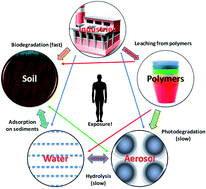Phthalate pollution: environmental fate and cumulative human exposure index using the multivariate analysis approach†
Abstract
A comprehensive review was performed on the environmental fate, environmental occurrence, toxicity, physical–chemical properties, abiotic and biotic removal and degradation of phthalate esters (PAEs) to compute the overall phthalate exposure and their impact on human beings. The removal and degradation of these wide spread pollutants by abiotic processes such as hydrolysis and photodecomposition are very slow and insignificant. On the other hand, the breakdown of PAEs by microorganisms is considered to be one of the major routes of environmental degradation for these widespread pollutants. Numerous microbial strains have been reported to degrade these compounds under aerobic, anaerobic and facultative conditions. Concurrently, the environmental fate, transport and transformation/degradation of these compounds under natural conditions are highly dependent on their physical and chemical properties. In order to understand the relationship between the concentrations of PAEs of different environmental compartments and human exposure prospects, a novel average phthalate pollution index (PPI) and cumulative phthalate exposure index (PEI) were proposed using the multivariate analysis approach. These indices were computed on the basis of relative importance, environmental occurrence, toxicity, physical–chemical properties, abiotic and biotic removal and degradation of dimethyl phthalate (DMP), diethyl phthalate (DEP), dibutyl phthalate (DBP), butyl benzyl phthalate (BBP) and diethyl-hexyl phthalate (DEHP). At present, the average PPI and cumulative PEI of 29 countries were evaluated using the concentrations of PAEs reported in the literature. These indices signify the overall phthalate pollution, human exposure and their interrelation. According to the index, Slovakia, Canada, Taiwan, Sweden and South Africa are among the top five countries in terms of cumulative phthalate exposure as per the existing data. The exposure percentage of total PAEs significantly varies between 23 and 44% since many environmental compartments are not directly exposed to human beings and they are degraded under natural conditions.

- This article is part of the themed collection: Environmental Science: Processes & Impacts: Recent Review Articles


 Please wait while we load your content...
Please wait while we load your content...